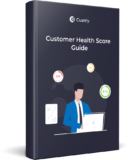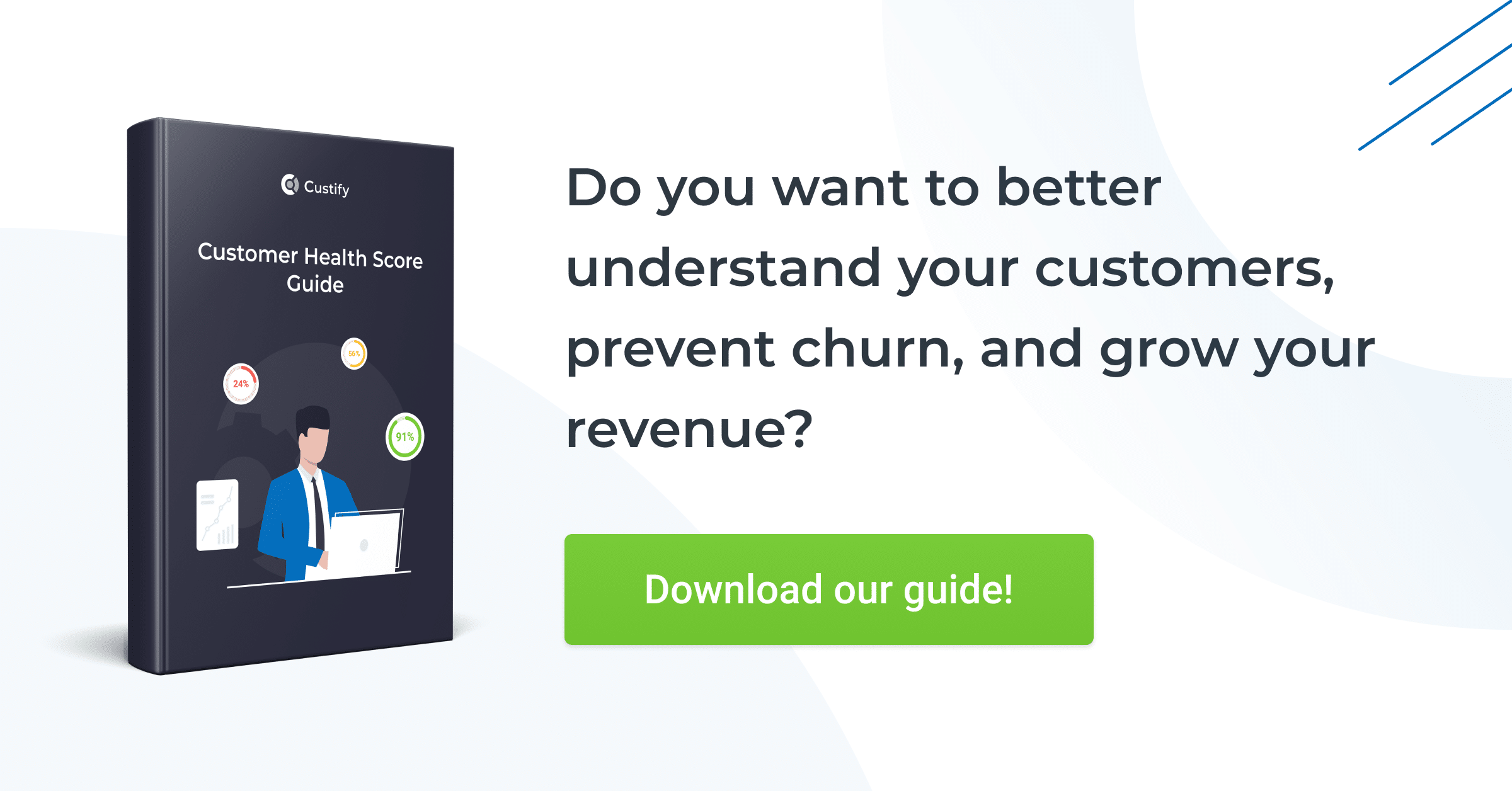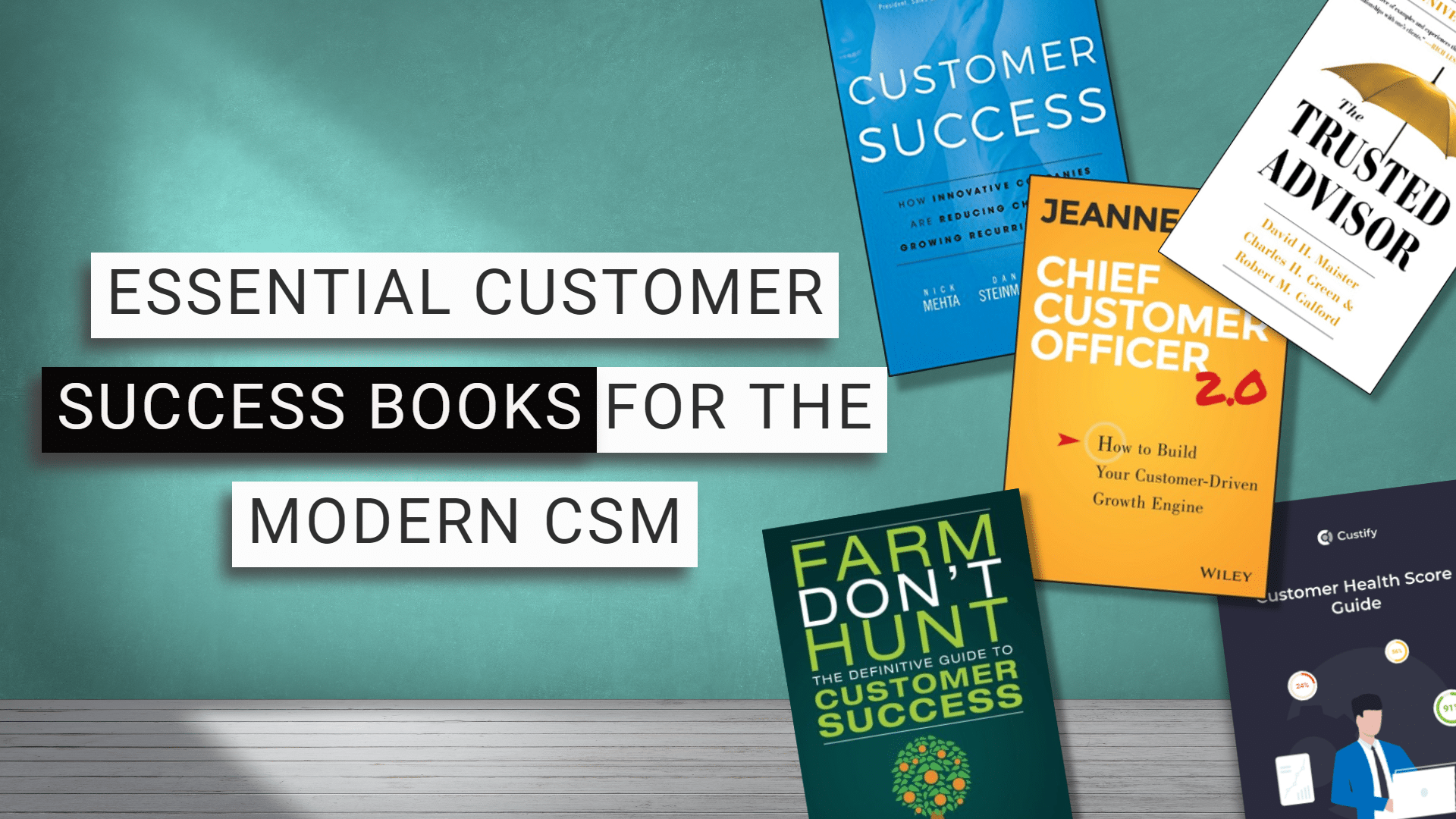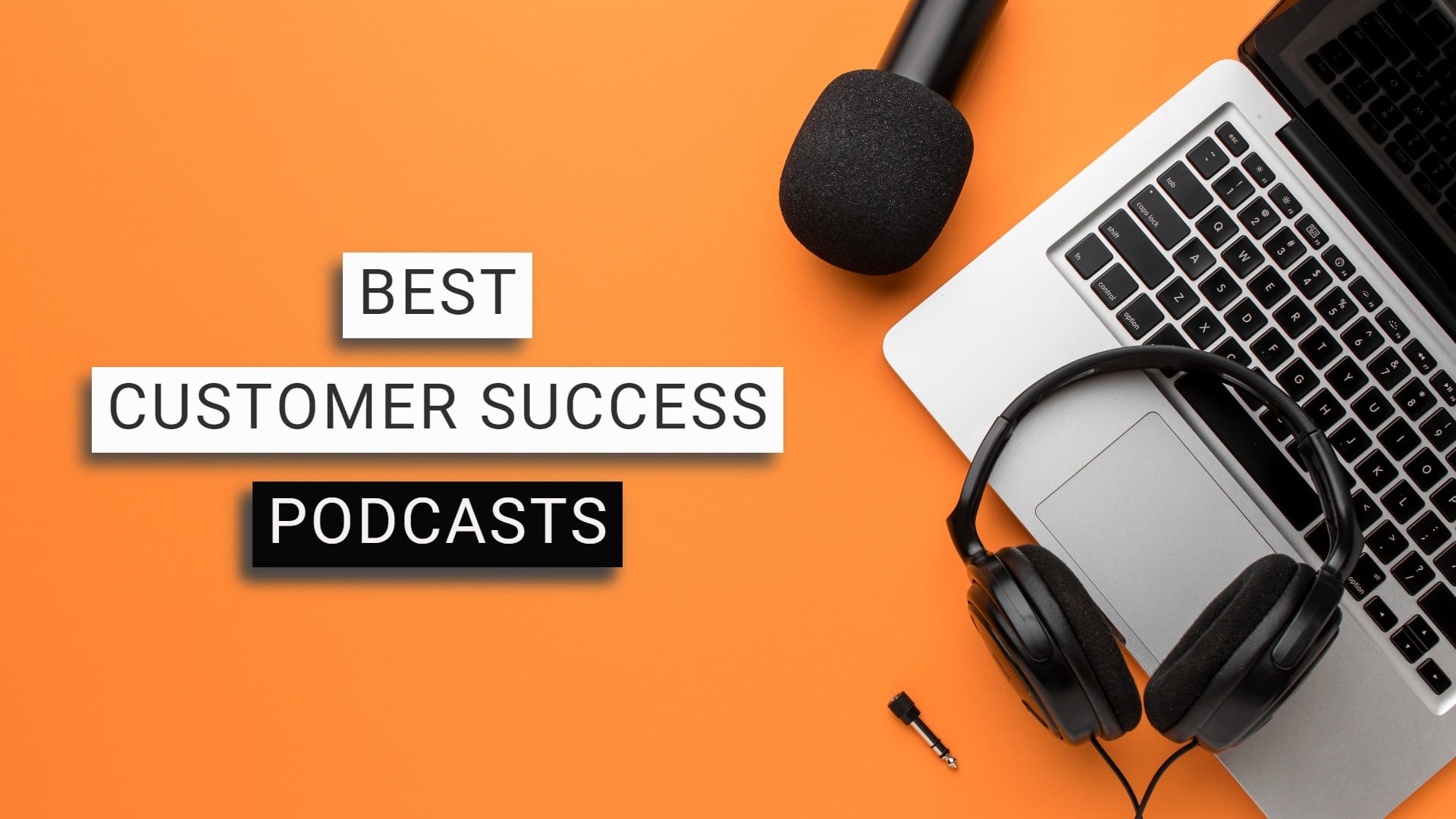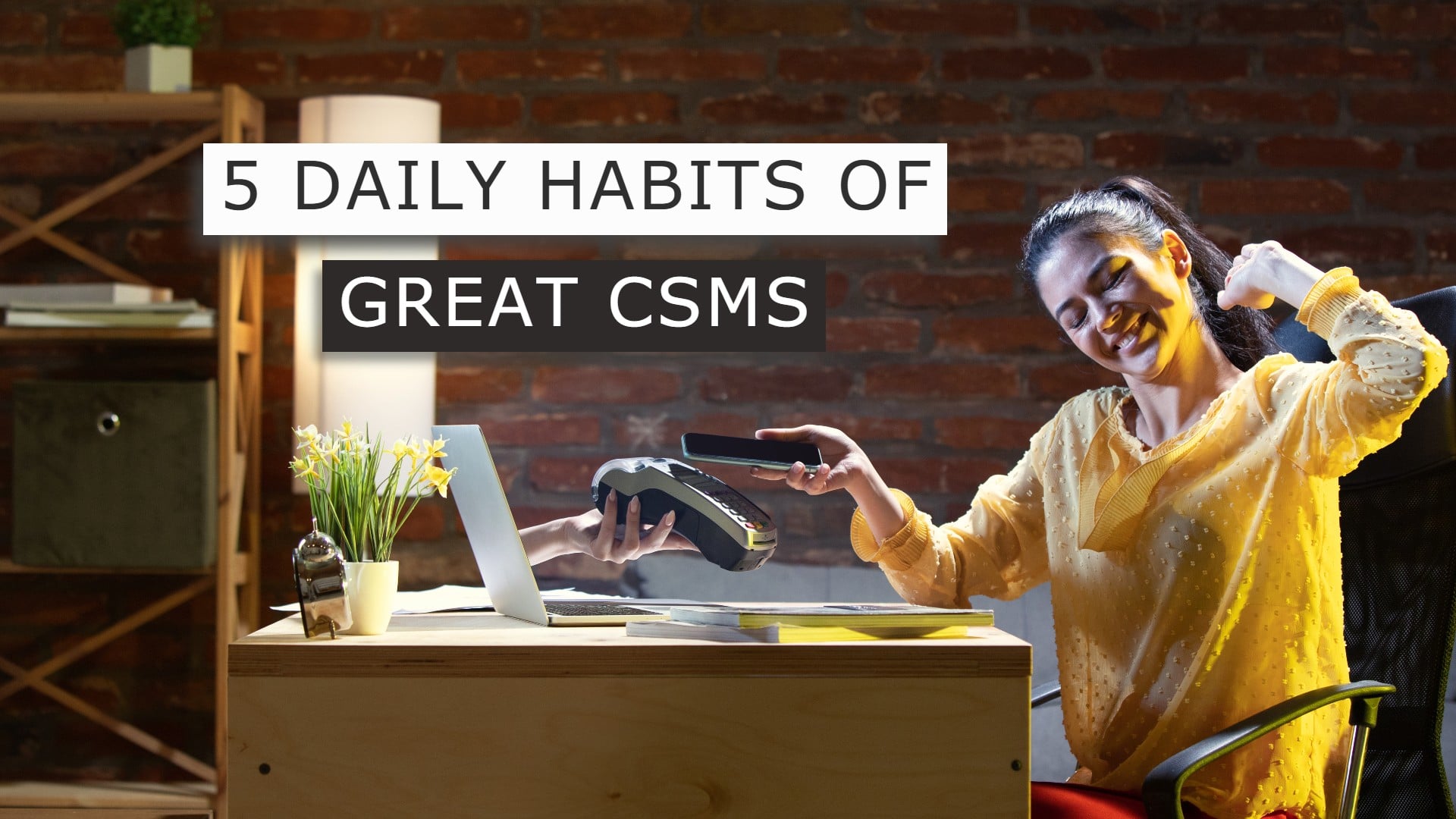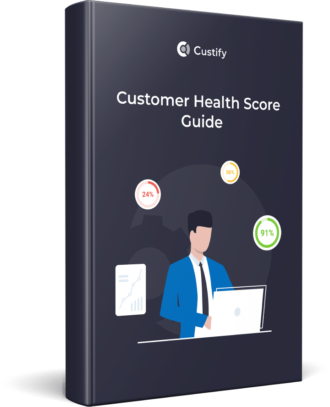About the Health Score Guide
We’ve put together this Customer Health Score guide to help Customer Success Managers improve their relationships with their customers. By following these suggestions, CSMs will be able to boost retention rates by identifying and addressing early signs of churn and increase revenue by identifying upsell and cross-sell opportunities.
Here’s what you’ll find in this guide:
- how to select the best metrics to track
- why a single Health Score is not enough to assess an account’s health
- how to measure and calculate Customer Health Scores
- why some Health Scores are more important than others, and how that reflects in the overall health of an account
- examples of Customer Health Scores.
Is this guide for you?
Customer Health Scores are a must for B2B SaaS businesses, but any business can benefit from applying the tactics described in this guide. Overall, this is a recipe for improving relationships with customers and growing your business.
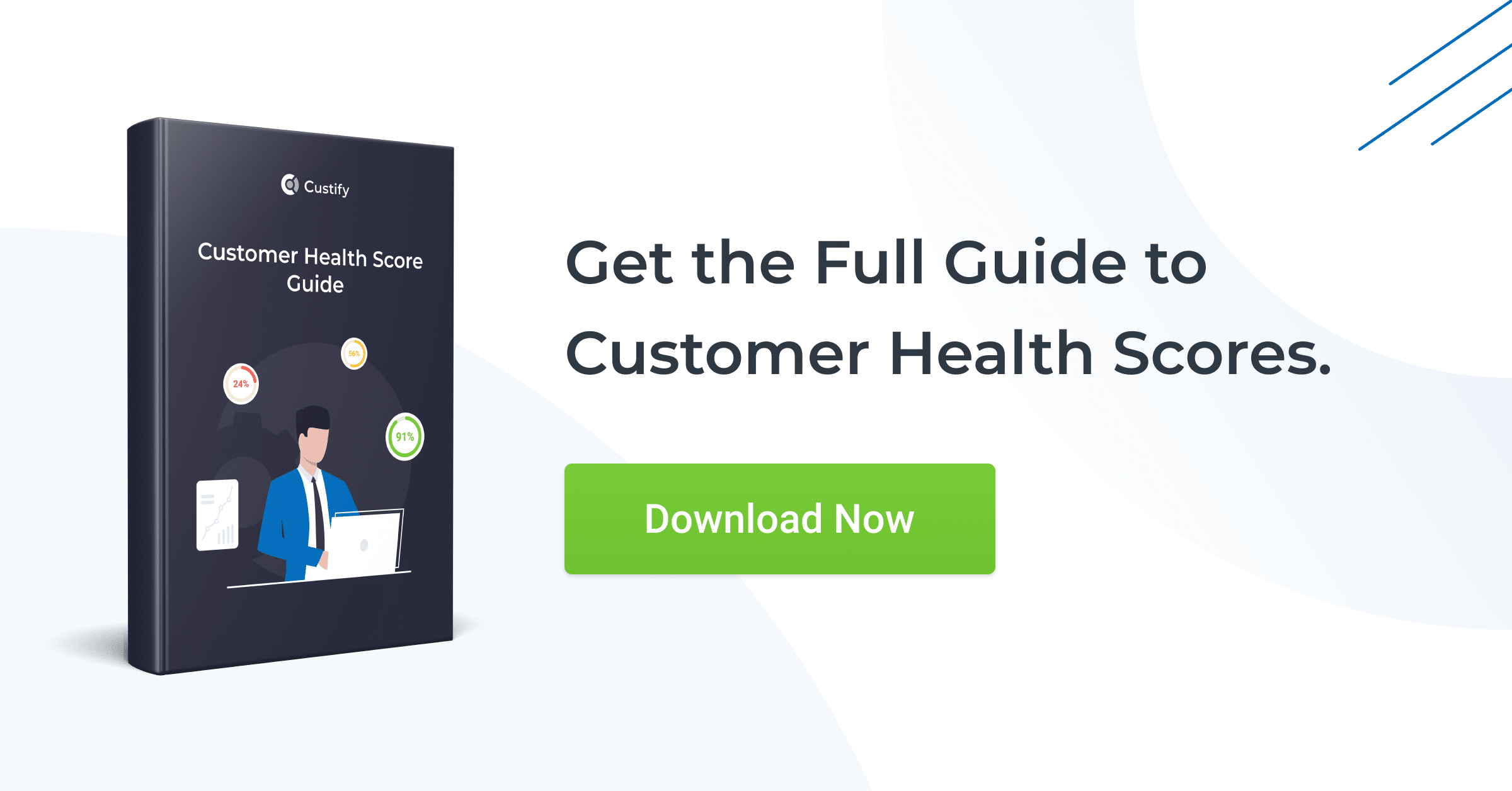
What are Customer Health Scores?
The Customer Health Score is a metric that helps a SaaS business assess the relationship with a customer – whether they’re in danger of churning or, on the contrary, ready to upgrade to a higher plan.
The importance of Customer Health Scoring can be summed up like this:
“When their needs are met and their expectations are exceeded, your customers are the best marketers in the world”
Think of a time a company / product has exceeded your expectations – how did that make you feel? Did you feel the need to tell all your friends about it?
The same thing happens in the SaaS industry as well. When a customer is happy with the service you provide, not only do they want to stay with you forever, but they want to recommend you to their peers as well.
Customer Health Scores & SaaS
Along with Customer Success as a core philosophy, calculating Health Scores has become the default for SaaS companies. That’s because, in most cases, Customer Success directly depends on how your customers use your product – which features they use and how often. If they don’t access specific features, they’re not getting the value out of your product and are, therefore, susceptible to churning (keep in mind that the signs of churning can be visible even months before the actual churn happens).
That’s why it’s crucial to analyze interaction at every touchpoint and determine which behavior leads to churn. Here’s how Szymon Gołyski, CMO at Channels uses Health Scores:
“We determine what actions (or lack of them) are the most common in the users that churned and we react each time the pattern starts. It gives us a great edge and we can win back more customers. It also helps us to engage our trial users into the app, as we have a dedicated onboarding based on what the user has done vs the ideal scenario.”
Note: Keep in mind that the most important Health Scores are always tied to the value a certain product provides (this is almost never “how often do my customers log in”, despite the fact that this is also a good secondary metric to measure).
Striving to ensure your customers have a high Health Score (by identifying and addressing pain points) not only helps you improve retention but also increase acquisition of new customers through referrals. Customer referral is a very powerful marketing tactic, and it’s particularly useful if the service you provide is expensive and/or requires a long-term commitment.
Because you’re analyzing your customers’ every interaction with your product, Health Scoring can also help you determine when they’re having trouble using a specific feature so you can reach out and help. Educating your customers on how to use your service to gain maximum value will go a long way towards ensuring they stay with you for a long time.
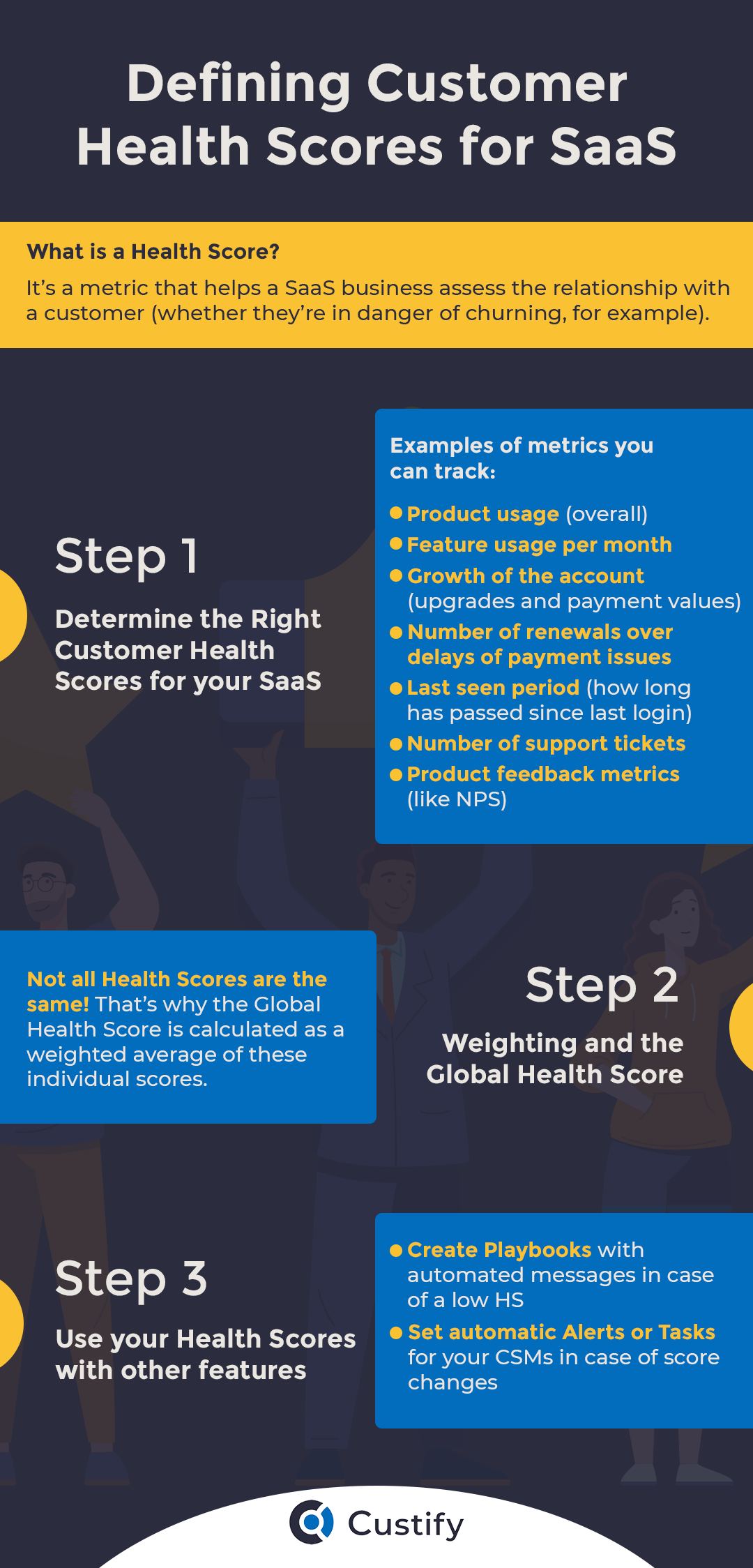
The Winning Strategy: Multiple Health Scores
Health is a very generic term, not a metric that you can just measure. Think of your own health, for example. There’s physical health, mental health, emotional health, spiritual health – they all come together to form your overall health.
The same applies in SaaS businesses’ case – there’s no one single Health Score. Instead, you have multiple signals (most often your product’s features) that you track and measure.
One of the reasons why having just one single Health Score is inefficient is because this doesn’t reveal the reason behind the score. For example, let’s say one of your customers has a Health Score of 44% (out of 100%). That’s below 50%, so it’s really bad!
But do you know why? You might have no idea, so you need to dig deeper to find out.
The Global Health Score
We’ve previously mentioned that Customer Health Scores are generally tied to product features. As not all features are equally important – almost all products have some main features (features that users must absolutely use to get value) and some secondary features (nice to have), some Individual Health Scores should also be more important than others.
Having a Global Health Score on top of these Individual Health Scores helps CSMs have an overall status of an account’s health, but the Individual Health Scores will always be the ones to provide in-depth information.
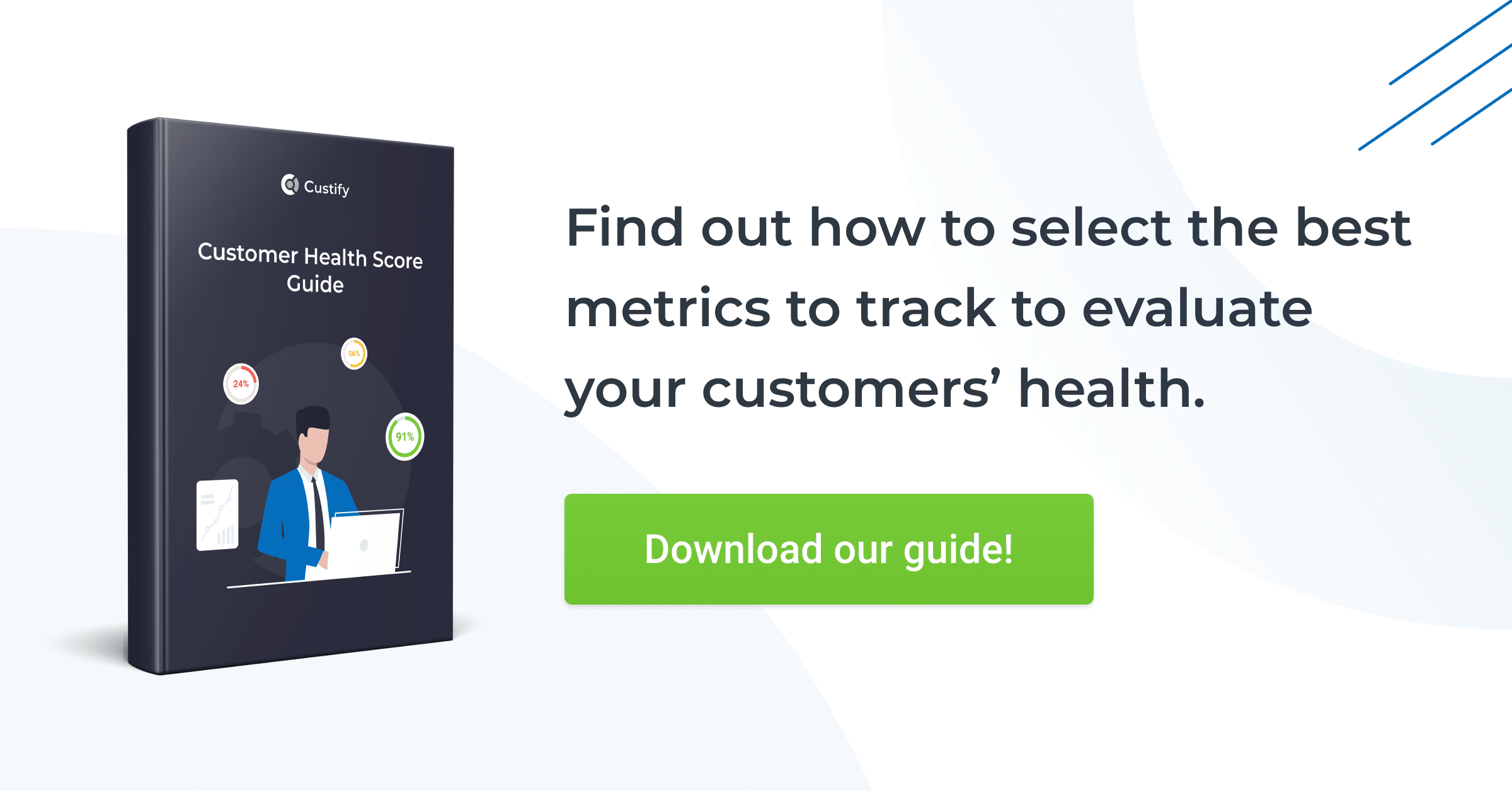
How to Measure Customer Health Scores
Ok, so you know you need some Individual Customer Health Scores and a Global one that encompasses them. But how do you determine them? Read on to find out.
Customer Health Score Metrics to Track
Before you get into calculations, you must first establish some categories for your Health Scores. A Health Score is more or less the same as a KPI that you define, and that shows you if a customer ranks well in that or not.
Each Customer Health Score can show you different things, like the risk of churn, upsell opportunities, how satisfied a customer is at a given time, or how they use your product, to name just a few.
Determining how Health Scores will fit into your overall Customer Success strategy will help you choose the right behavior metrics you should monitor to accurately measure Customer Health.
Health Scores vary significantly by industry, and how you calculate them for your customers depends on the metrics you find most relevant for your business. Here are some examples:
- product usage, along with the depth of usage (the percentage of your product they use) and breadth of usage (the number of licenses they have)
- usage of your product’s core features and activity in the product
- growth of the account (whether they’ve upgraded over time)
- length of the relationship
- number of renewals completed (and also if there are frequent payment problems)
- number of support tickets
- product feedback metrics
- marketing participation (whether they recommend you to other businesses or if they’re willing to create a case study with you).
Customer Health Score Weighting and Impact
Not all Health Scores are equally important – remember the logins example? Therefore, they shouldn’t have the same weight in the calculation of the Global Health Score.
In the graphic below, you can see that, in Custify, we enable you to choose the impact of a particular Health Score on the calculation of the Global Health Score between None, Low, Medium, and High.
A metric like logins should have none or low impact on the calculation of the Global Health Score, while a metric like File Uploads should have a medium or high impact, depending on how crucial it is for your product.

Customer Health Score Formulas
There’s no such thing as a magical formula for determining account health. Instead, you create this formula from scratch when you analyze and combine the metrics that matter most for your product.
Every SaaS business is different, they all have their own particularities, so it’s wrong to assume that there’s a one-size-fits-all Customer Health Score formula that will work for all products like some Customer Success tools lead you to believe.
By simply going through the process of creating Customer Health Scores inside a CS tool like Custify, you will eventually reach an ideal formula for your business. Or maybe your perfect setup involves several ideal formulas, one per customer stage (onboarding, discovery, regular, long-term, etc.). Your Health Score particularities make that formula work for you. Others might inspire you, but in the end, only you can know for certain how your healthy customers look like.
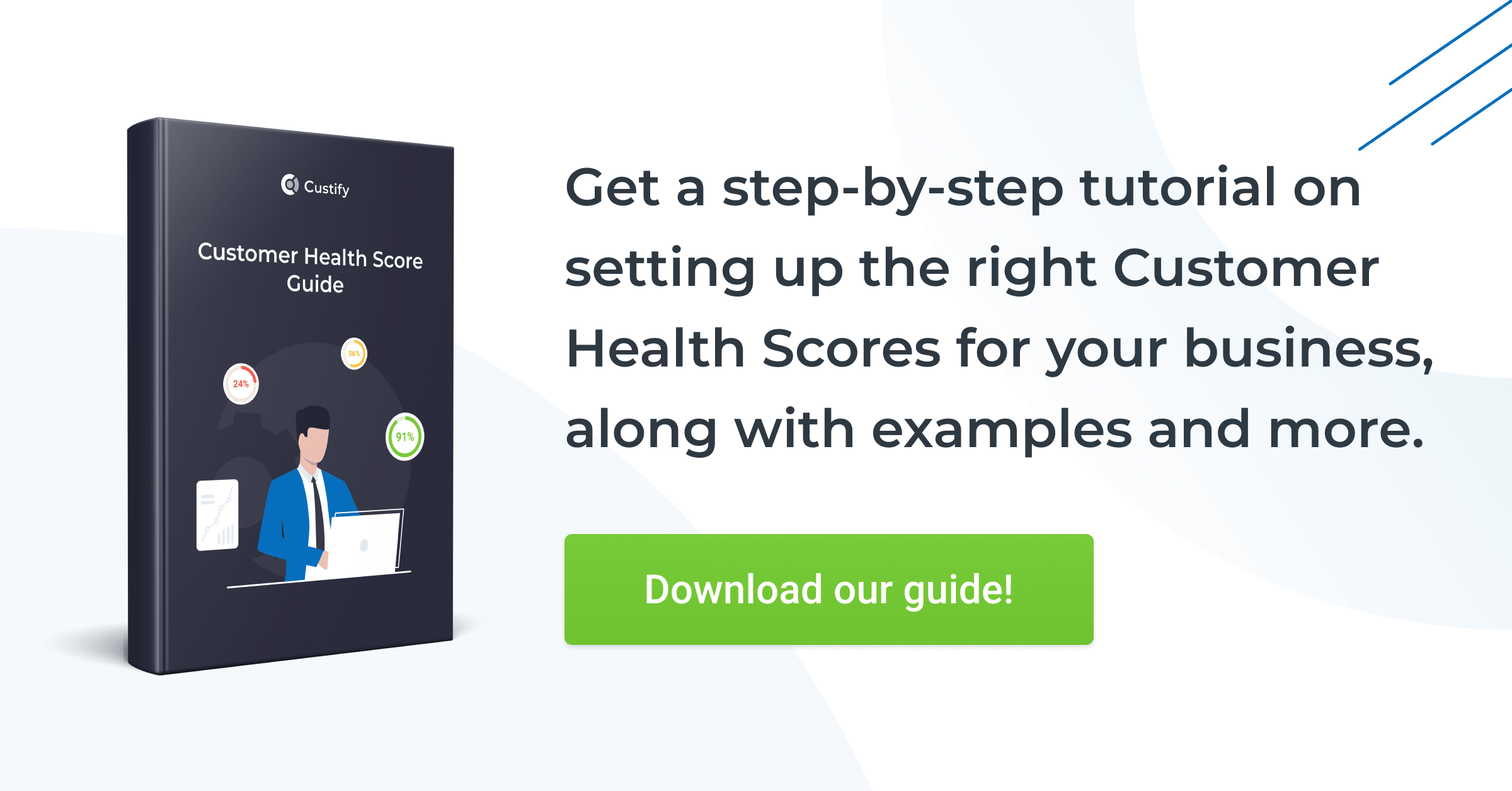
Using Health Scores for Customer Success
By regularly monitoring Customer Health Scores, early signs of increased friction or declining customer engagement become easier to identify.
Most of the actions that influence your relationship-building efforts benefit from being well-timed with your customers’ progress. Here are a few examples:
- proactively reaching out on a regular basis
- checking in after a problem was solved
- following up on previous interactions
- identifying upselling and cross-selling opportunities
- providing information on new features or events.
If you truly want to drive Customer Success, it’s critical to constantly keep an eye on your customers’ lifecycles in order to make informed decisions that drive value. Analyzing every interaction with your product will help you determine when customers face issues with a specific feature so you can jump in and reach out to them with the solution they need.
You’ll get the chance to address issues before they cause churn, and your product will stay top-of-mind. You’ll capitalize on opportunities and increase adoption rates. It’ll undoubtedly bring value in the long term. But it gets difficult to efficiently keep track of all these metrics without the help of playbooks and automation.
In Custify, Playbooks are useful additions that help you improve loyalty, adoption, conversion, and churn rates while customers move through their lifecycle stages. A playbook is basically a set of tactics that helps you drive Customer Success by pinpointing these exact moments for your customers. You’ll be able to improve your overall customer engagement, and it will enable you to have a customer-centric approach to drive additional revenue.
Having information about churn likelihood, product usage, lifecycle phases, and other KPIs can help take your CS program to the next level.
Automation will be a big help here. For example, after a customer support ticket is closed, you can send an automated notification to the associated Customer Success rep a week later, reminding them to follow up.
Besides helping your team collect and disseminate real-time information about your customers, automation drives proactive, personalized engagements that create a more consistent experience and ultimately increases renewals & reduces costs.
So based on your Customer Health Scores, you’re then able to create playbooks that will automatically trigger a number of actions:
- assign accounts to team members (for example, problematic customers to more experienced CSMs)
- send messages to customers with low engagement
- notify you if certain Health Scores drop under a defined value
- create tasks for CSMs to proactively get in touch
- identify upselling and cross-sell opportunities
- filter for very healthy customers that are good candidates for referrals / case studies / testimonials
And much more. You can actually enjoy nearly endless automation possibilities if you implement a flexible workflow.
One of the biggest advantages of automating your playbooks is that it will allow you and your CSMs to have a clearer & standardized path to approaching your customers exactly when they need it the most. It basically takes away the ambiguity and leaves more room for creating a consistent customer experience.
Aligning your business goals with your customers’ needs and objectives helps you create a customer-driven model which has been proven to be 60% more profitable than traditional digital or personal systems.
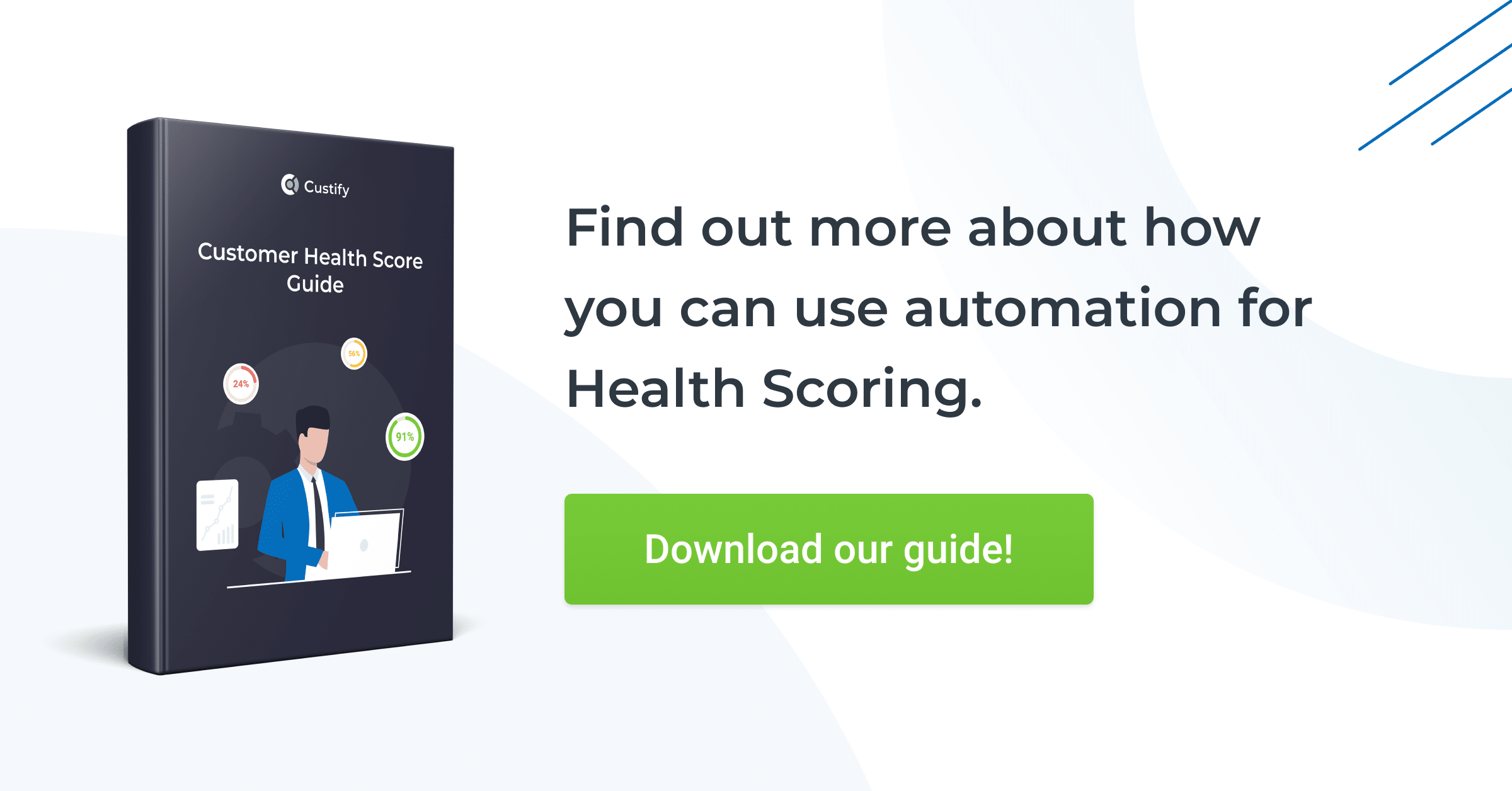
Using Your SaaS Integrations for Customer Health Scores
You probably already use several tools to run your business – a CRM, a support ticketing system, a billing solution, etc. Within those tools, typically, there’s also data that can be used for Health Scores – you should therefore integrate all these tools with your CS platform.
Because the more integrated your tech stack is, the more processes you can automate and the more data you can track afterward. And that’s of big help to all the teams in your company.
Using Customer Health Scores that integrate with your other tools and software will enable you to exponentially increase both the value you get from them and the success of your customers.
For example, you can maximize the probability of renewals, upsells, and user success by integrating solutions for your payment & billing, helpdesk & support, or any other software you use.
Get Started with Customer Health Scores
We know measuring account health is a long, arduous, and ever-changing journey, and the concepts described above can be overwhelming. That’s why we’ve put together this step-by-step guide that can help you set up Customer Health Scores in just a few days.
By using the advice in our guide, you can:
- reduce churn
- improve new customer acquisition through referrals
- increase your revenue through upsells and cross-sells
- improve your product over time
- understand your customers and educate them on how to best use your product.
Also, you’re not alone in this! If you choose to use Custify, we’ll offer you a concierge onboarding service where we’ll use our years of experience to help you get the most out of our tool.
We know every customer is different. So we make sure you always see the full picture, whether that means problems with the product, during onboarding, or with your team.
Here’s what Custify can help you achieve:
- a 360° view on customers
- a churn rate of under 2%
- more renewal, growth, and upsell opportunities
- proactive customer issue resolution
- automated outreach.
